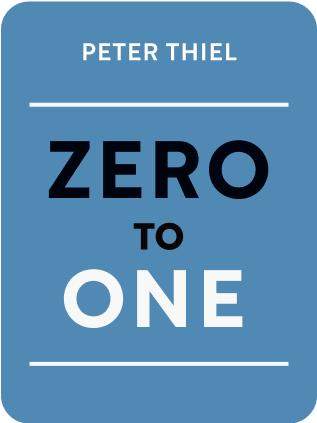

This article is an excerpt from the Shortform summary of "Zero To One" by Peter Thiel. Shortform has the world's best summaries of books you should be reading.
Like this article? Sign up for a free trial here .
What are some startup lessons learned from the dot-com bubble? How can you avoid making the same mistakes?
These startup lessons learned stem from the dot com bubble in the 1990s. In Zero to One, Peter Thiel offers advice on how to avoid pitfalls of new companies, and shares startup lessons learned.
Startup Lessons Learned From the Dot-Com Bubble
Remember the question, “What important truth do few people agree with you on?” To get an answer that points to the future, start with another question: “What does everyone agree on?” This can help outline startup lessons learned from the past.
The real truth is often the opposite of what everyone agrees is true. When you’re blinded by the latest conventional wisdom, you can’t create anything new.
Conventional wisdom helped create the dot-com bubble. The basic principle that companies need to make money was replaced in the late 1990s by a delusion that became the new conventional wisdom: companies racking up enormous, unending losses are actually succeeding because the losses are investments in future success. In the “New Economy,” where no loss was too big to tolerate, page views became a more relevant metric than profits.
We understand how wrong these accepted beliefs were only in retrospect. When they fall apart, we refer to the delusional beliefs as a bubble. But bubbles continue to influence our thinking long after they collapse because we draw the wrong lessons from them.
The tech bubble of the 1990s was the biggest bubble since the one ending in the Wall Street crash of 1929—the “lessons” of the dot-com dictate the way we think about tech today.
Thinking clearly about the future requires questioning what everyone “knows” about what happened in the past. To understand the real lessons of the tech bubble for startups today, it’s useful to review the 1990s.
A History of the 1990s
In order to consider startup lessons learned, you need to consider the entire history of the dot com bubble. We remember the 1990s mostly positively for the rise of the internet, but the 18-month dot-com bubble at the end occurred against a backdrop of growing financial problems in the U.S. and globally.
The decade started euphorically with the fall of the Berlin Wall in 1989. But in the early 1990s, the U.S. was slowly and painfully recovering from a recession. Unemployment climbed as the economy began a long shift from manufacturing to a service emphasis. From 1992 through 1994, the mood was anxious as jobs migrated to Mexico and concerns grew about globalization and competitiveness. The economic anxiety sank George H.W. Bush’s reelection chances and fueled billionaire H. Ross Perot’s third-party bid.
Silicon Valley was sleep-walking, and Japan seemed to be winning the trade war over the export of semiconductors. A tech turning point came in late 1993 with the first release of a user-friendly internet browser, Mosaic, which became Netscape Navigator. Now that everyone (not just academics and government employees) had a way to get online, the internet took off with the rise of Netscape, Yahoo, Amazon, and other companies.
By spring 1998, due to the tech excitement, each company’s stock had quadrupled even though they weren’t making profits. In December 1996, a prescient Fed chairman Alan Greenspan warned of “irrational exuberance” or overvaluing companies, startup lessons learned the hard way. This was three years before the tech bubble burst.
Problems were brewing in an increasingly connected global economy. Massive foreign debt and crony capitalism (scheming between business and government) created an Asian financial crisis in July 1997. Russia followed with a financial crisis year later when it devalued the ruble and defaulted on debt. Russia’s instability scared American investors, and the Dow plunged.
The ruble crisis started a domino fall leading to the collapse of the U.S. hedge fund Long-Term Capital Management in the second half of 1998. The Fed stepped in with a bailout and cut interest rates to prevent system-wide disaster. Europe was in trouble too—the euro launched in January 1999 but had to be propped up by mid-2000.
So global financial problems were the backdrop for the dot-com mania that started in September 1998. The reasoning went that the Old Economy couldn’t handle global challenges—the only answer was the New Economy of the internet.
Dot-Com Mania
For 18 months, from September 1998 to March 2000, Silicon Valley was awash in money, which attracted throngs of exuberant, sometimes disreputable people. New startups threw extravagant launch parties. “Paper millionaires” racked up entertainment bills and tried to pay them with shares of startup stock, sometimes succeeding. People left lucrative jobs to found or join startups.
The fact that the “anti-business model” (losing money to grow) was unsustainable should have been obvious. But there was a certain logic to enjoying the irrational while it lasted.
Startup Lessons Learned From the Crash
After the NASDAQ reached a peak of 5,084 in March 2000, it fell to 3,321 by the middle of April (the dot-com bust).
By the time it hit bottom at 1,114 in October 2002, the nation had learned its lesson and reinterpreted the hope and exuberance of the tech boom as greed. They were wary of the future and skeptical of companies with big plans.
In the 1990s, investors had predicted a shift in the economic focus “from bricks to clicks.” After the bust, they turned away from technology and back to bricks (the housing market), which resulted in another bubble—in real estate in 2006. They didn’t benefit from startup lessons learn, and shifted from one bubble to another.
From the dot-com crash, Silicon Valley absorbed four startup lessons learned that continue to influence entrepreneurial thinking.
1) Make incremental advances: Be wary of big visions that drive bubbles. Move forward with small, incremental steps.
2) Stay lean and flexible: To stay lean and flexible, don’t tie your hands with planning. Instead, try things and iterate or build on the ones that work.
3) Build on the competition: Don’t try to create new markets because it’s too risky. Build your business by improving on something people are already buying from someone else.
4) Focus on product, not sales: Tech is about product development, not sales and distribution. If you have a good product, it should spread virally without a need for advertising. During the dot-com bubble, companies wasted money on advertising; viral growth is the only growth that’s sustainable.
Tech startups treat these lessons as sacrosanct; to ignore them is to court disaster. But the opposite of each lesson is likely more accurate:
- It’s better to be bold than inconsequential.
- A bad plan is better than none.
- Don’t compete: competition destroys profits.
- Sales strategy matters as much as product.
The hubris of the late ‘90s and its downfall—the dot-com crash—are clear. Startups had the right idea of going from 0 to 1, although few actually did it. But amid the insanity, some recognized the value and need for technology and creators.
We still need new technology and a certain amount of arrogance to create it. Building the next generation of tech companies will require rejecting the conventional wisdom spawned by the crash. Opposite principles aren’t automatically true though.
Instead, ask how your beliefs about business may be affected by misreading the lessons of past mistakes. Rather than simply oppose the crowd, think for yourself.
It can be hard to grapple with startup lessons learned. But Thiel argues that it’s an important part to consider during any new startup venture.

———End of Preview———
Like what you just read? Read the rest of the world's best summary of Peter Thiel's "Zero To One" at Shortform .
Here's what you'll find in our full Zero To One summary :
- Why some companies genuinely move the world forward when most don't
- How to build a company that becomes a monopoly (and why monopolies aren't bad)
- Silicon Valley secrets to selling products and building rockstar teams






